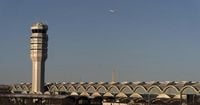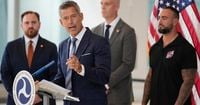Millions of travelers across the United States are bracing for major disruptions as the federal government prepares to slash flight capacity by 10% in 40 of the nation’s busiest markets starting Friday morning, November 7, 2025. The drastic measure—announced jointly by Secretary of Transportation Sean Duffy and Federal Aviation Administration (FAA) Administrator Bryan Bedford—comes as the country’s longest-ever government shutdown grinds into its sixth week, with no end in sight and mounting pressure on the nation’s already strained air traffic control system.
According to the Associated Press, the US air system handles more than 44,000 flights daily, ranging from commercial passenger jets to cargo and private planes. The impending cuts could ground as many as 4,000 to 5,000 flights each day, depending on how airlines and airports adjust their schedules. The announcement has left airlines scrambling and travelers anxious, as the specific airports and markets affected remain undisclosed until Thursday, just hours before the new restrictions take effect.
At the heart of the crisis is a severe shortage of air traffic controllers, who have been working without pay since the shutdown began on October 1. The first missed paycheck arrived on October 28, and a second is looming next week. As the shutdown stretches on, more controllers are calling in absent, and those still reporting for duty are being pushed to their limits with mandatory six-day workweeks. Financial stress and fatigue are mounting, with some controllers reportedly taking on side jobs to make ends meet, as reported by New York Post.
“We are seeing pressures build in a way that if we allow it to go unchecked, will not allow us to tell the public that we operate the safest airline system in the world. And we are not going to react to that. We intend to be proactive,” Bedford stated at a press conference, as quoted by New York Post. Duffy echoed the urgency, warning that “chaos in the skies” could erupt if controllers miss another paycheck next Tuesday. He emphasized, “We do not want to see disruptions at the FAA or here at the DOT, but our number one priority is to make sure when you travel, you travel safely.”
The FAA’s decision is grounded in data from voluntary safety reports filed by pilots and mounting evidence of controller fatigue. Last weekend alone, at least 39 control centers reported limited staffing—up from a pre-shutdown average of just eight, according to Associated Press analysis. “The data’s telling us we need to do more, and we are going to do more,” Bedford said, underscoring the agency’s intent to act before a true crisis emerges. “We’re not going to wait for a safety problem to truly manifest itself when the early indicators are telling us we can take action today to prevent things from deteriorating.”
The move is expected to have ripple effects throughout the aviation industry and beyond. Airlines for America, the industry’s main trade group, said in a statement that it is “working with the federal government to understand all details of the new reduction mandate and will strive to mitigate impacts to passengers and shippers.” Southwest Airlines, for its part, told reporters that it is reviewing schedules and will contact travelers whose flights may be affected. “We continue to urge Congress to immediately resolve its impasse and restore the National Airspace System to full capacity,” the airline said.
Travelers are already feeling the pain. New York area airports have seen mounting delays, with a collision between two planes on the tarmac at LaGuardia Airport last week and security lines at Houston’s George Bush Intercontinental Airport stretching for hours. Orlando International Airport, a critical gateway for Florida’s amusement parks, is reportedly on the brink of total closure as repeated cancellations and staff shortages mount. The FAA has attributed many of these disruptions to the growing controller shortage.
Beyond the immediate travel headaches, the shutdown threatens to leave lasting scars on the aviation workforce. “It takes years to bring more well-trained certified controllers into the airspace,” Duffy explained, highlighting the slow pipeline for recruiting and certifying new staff. The shutdown has frozen hiring and training efforts, further exacerbating the shortage and raising concerns about long-term impacts on air safety and system capacity.
Political reactions to the FAA’s move have been swift and sharply divided. On Capitol Hill, Republicans have seized on the flight cuts to criticize Democrats for failing to reach a deal to fund the government. Sen. Jerry Moran (R-Kansas), who chairs a key Senate Commerce Committee panel overseeing aviation, called the action “a harsh but necessary consequence of this useless shutdown.” Sen. John Barrasso (R-Wyo.), the Senate’s No. 2 Republican, went further, saying, “We need to make sure the flying public is protected. The Democrats don’t seem to care at all about that.” Meanwhile, Sen. Bernie Moreno (R-Ohio) expressed hope that the cuts would pressure Democrats to come to the negotiating table.
Democrats, for their part, have largely deferred to the FAA’s expertise. Sen. Maria Cantwell (D-Wash.), the top Democrat on the Senate Commerce Committee, said, “They’re the ones with the data, so don’t know,” but added that regulators should “do whatever they think it takes to make the flying public safe” and called for the FAA to be more aggressive in its approach.
Industry leaders and safety officials have also weighed in. Jennifer Homendy, chair of the independent National Transportation Safety Board, praised the administration’s move in a social media post, saying that conducting safety risk assessments and then using data to mitigate risk is “exactly” what the administration should be doing.
The shutdown’s impact on air travel is not without precedent, but this episode is testing the system like never before. Duffy referenced a deadly midair collision in January 2025 near Reagan National Airport as a cautionary tale: “We learnt from that. Now we act before a crisis develops, that’s what’s happening here today.”
Despite the dramatic cuts, both Duffy and Bedford have repeatedly reassured the public that air safety remains paramount. “I want to reassure the American travelers that it is absolutely safe” to fly in the United States, Bedford said. The FAA’s approach, he explained, is both “prescriptive” and “surgical,” focusing on the highest-traffic markets and using real-time data to guide decisions. The agency plans to release the full list of affected airports and markets on Thursday, November 6.
As the shutdown drags on, the question on everyone’s mind is how long the restrictions will last. Duffy suggested that the decision to lift them will be “data-driven,” with a likely correlation between restoring government funding, resuming controller pay, and reopening the airspace to full capacity. For now, though, the nation’s skies will be a little quieter—and a lot more uncertain—as the country’s air travel system weathers one of its most challenging chapters yet.
With the clock ticking toward Friday’s deadline, airline executives, government officials, and millions of travelers are left hoping for a breakthrough that will bring an end to the shutdown and restore America’s skies to normal.





